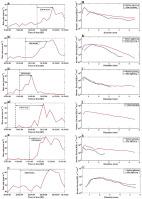Atmospheric Research ( IF 4.5 ) Pub Date : 2021-05-04 , DOI: 10.1016/j.atmosres.2021.105663 Dipjyoti Mudiar , Sunil D. Pawar , Anupam Hazra , V. Gopalakrishnana , D.M. Lal , Kaustav Chakravarty , Manoj A. Domkawale , M.K. Srivastava , B.N. Goswami , E.R. Williams

|
Many studies of cloud electrification have suggested that the presence of precipitation in the mixed phase region of the cloud is essential for charge separation and lightning initiation in clouds. However, observations of the rain gush phenomenon, a transient amplification in near-surface intensity after an overhead lightning also suggest that the lightning discharge can substantially enhance precipitation intensity at the ground. But the microphysical link between lightning and enhanced precipitation intensity after lightning is not well understood. With the observation of a transient amplification in the rain intensity and broadening of the corresponding Raindrop Size distribution (RDSD) after the lightning, it is inferred here that the lightning-induced atmospheric ions and prevailing electrical forces may potentially modulate the RDSD as well as the rain intensity by influencing the collision-coalescence process and the growth rate of raindrops after lightning. The time delay between the lightning and subsequent increase in rain intensity at the Earth's surface was observed to be between 2‐4 min. Also, a good correlation was observed between the variations in lightning frequency and the rain intensity during thunderstorms with an average time lag of 4 min. Piepgrass et al. (1982) have reported a good correlation between lightning frequency and rainfall when the precipitation lagged the lightning by times of 4 and 9 min. These observations indicate that the association between lightning frequency and rainfall with 4-min time lag (the shorter one) may be a result of the lightning-induced growth of raindrops below the melting layer rather than the enhancement in precipitation in the mixed phase region of cloud. The new knowledge, coupled with our related work (MUDIAR et al., 2018) on stratiform clouds provides a compelling basis for the parameterization of the electrical processes in weather/climate models.
中文翻译:

闪电和降水:观测到的雨滴大小分布可能的电气改变
许多关于云带电的研究表明,云的混合相区域中存在沉淀对于云中的电荷分离和雷电引发至关重要。然而,观察到雨涌现象,高架闪电后近地表强度的瞬时放大也表明,雷电放电可以显着增强地面的降水强度。但是,雷电与雷电后增加的降水强度之间的微物理联系还不是很清楚。观察到闪电强度会瞬时放大,雷电后相应的雨滴大小分布(RDSD)会变宽,在此推断,雷电感应的大气离子和主导的电势可能会通过影响碰撞结合过程和雷电后雨滴的生长速率来潜在地调节RDSD和降雨强度。观察到闪电与随后的地球表面降雨强度增加之间的时间延迟在2-4分钟之间。另外,雷暴期间雷击频率的变化与降雨强度之间存在良好的相关性,平均时滞为4分钟。Piepgrass等。(1982年)报告说,当降水落后4分钟和9分钟时,闪电频率与降雨之间存在良好的相关性。这些观察结果表明,闪电频率与降雨之间有4分钟时滞(较短的时间)之间的关联可能是由于闪电引起的融化层以下雨滴的生长,而不是降雨在混合相区的增加所致。云。新知识,加上我们在层状云上的相关工作(MUDIAR等,2018),为在天气/气候模型中对电气过程进行参数化提供了令人信服的基础。











































 京公网安备 11010802027423号
京公网安备 11010802027423号